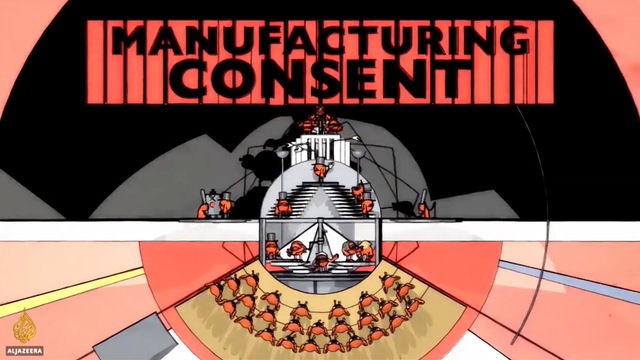What is “The Manufacturing Consent”?
The concept viewed by Noam Chomsky and David S Herman called ŌĆ£Manufacturing ConsentŌĆØ argues that mass media communicate messages and symbols by entertaining or informing the audience with values that will allow them to be integrated into larger society. This shows how mass media serve the system to control society by building opinions formed by the public to benefit the higher institutions.┬Ā
The Propaganda Model – 5 filters

In the concept of Manufacturing Consent, Noam Chomsky and David Herman introduced ŌĆ£The Propaganda ModelŌĆØ. Chomsky and Herman believe it ‘focuses on this inequality of wealth and power and its multi-level effects on mass media and choices’. This model consists of five different filters, and its main objective is to understand how institutional pressures in a profit-driven environment shape media behaviour.
Ownership: This first filter consists of media companies sharing the same interests with different sectors of the economy, allowing them to profit by preserving an economic and political climate. However, independent media companies are eliminated.┬ĀAdvertising┬Āis a market-driven orientation of the media, as it is used as its primary source of revenue.┬ĀSourcing┬Āis how official sources dominate the press and are considered objective and reliable. Unfortunately, the people are rarely the source of media.┬ĀFlak┬Ārefers to negatively responding to media content, such as a reporter getting discredited or threatened.┬ĀAnti-communism┬Āwas manifested during the Cold War, and it prepared the population against a common threat by portraying critics of government policies as unpatriotic or supportive of the enemy.
How do Streaming Services and Manufacturing Consent link?

Every day, society benefits from streaming platforms such as Netflix, YouTube or Disney+. But where does the Manufacturing Consent concept take place with these streaming services?
The algorithm can be an example because it combines human knowledge and machine learning to guide the audience in watching specific content. The algorithm used in these streaming services has one task: maximise engagement, which will automatically bring significant profit. For example, the more YouTube videos are viewed, the more money it will make. However, the algorithm doesnŌĆÖt allow society to have the liberty of receiving different types of content because its priority is to orient with the userŌĆÖs previous activity on the platform. The content personalisation of these services can create users a sense of repetitiveness of the same themes or ideologies.
Conclusion

To conclude, the concept of Manufacturing Consent shows that even streaming services have the power to show specific content which society can find, with the scope of making a profit. These services can also normalise the attitudes or political positions of those watching movies or TV shows, merging them with the attention brought by the audience.┬Ā
Bibliography
- Devyn Hinkle (2021) How Streaming Services Use Algorithms. Available at: https://amt-lab.org/blog/2021/8/algorithms-in-streaming-services#:~:text=This%20person%20came%20to%20us,of%20algorithms%20on%20streaming%20sites
- Durham, Meenakshi Gigi (2006)┬ĀMedia and cultural studies: keyworks.┬ĀWiley-Blackwell
- Marcela Pizarro (2022) Is mass media still ŌĆśmanufacturing consentŌĆÖ in the internet age? Available at: https://aeon.co/videos/is-mass-media-still-manufacturing-consent-in-the-internet-age
- Simon Enoch (2013) The Propaganda Model. Available at: https://beautifultrouble.org/toolbox/tool/the-propaganda-model


I like the way you explained what the propaganda model is and you named all 5 filters which are a part of the propaganda model. Then you go on to talk about how the propaganda model links to streaming services and you’ve shown that very well. I also like the way you format your blog. Maybe you could have talked a bit about hegemony but other than that its great.